Cave diving is one of the most fascinating yet challenging forms of underwater exploration. For adventurous divers, few experiences match the thrill of swimming through hidden chambers and unique formations found only in underwater caves.
However, despite its alluring mystery, cave diving is something that needs extensive training and careful preparation. This article aims to provide a clear and comprehensive guide for those considering this extreme adventure.
Disclaimer: Cave diving carries significant risks, including the potential for serious injury or even death. It should only be attempted with proper certification, training, and equipment under the guidance of experienced professionals.
The Difference Between Cavern vs Cave Diving
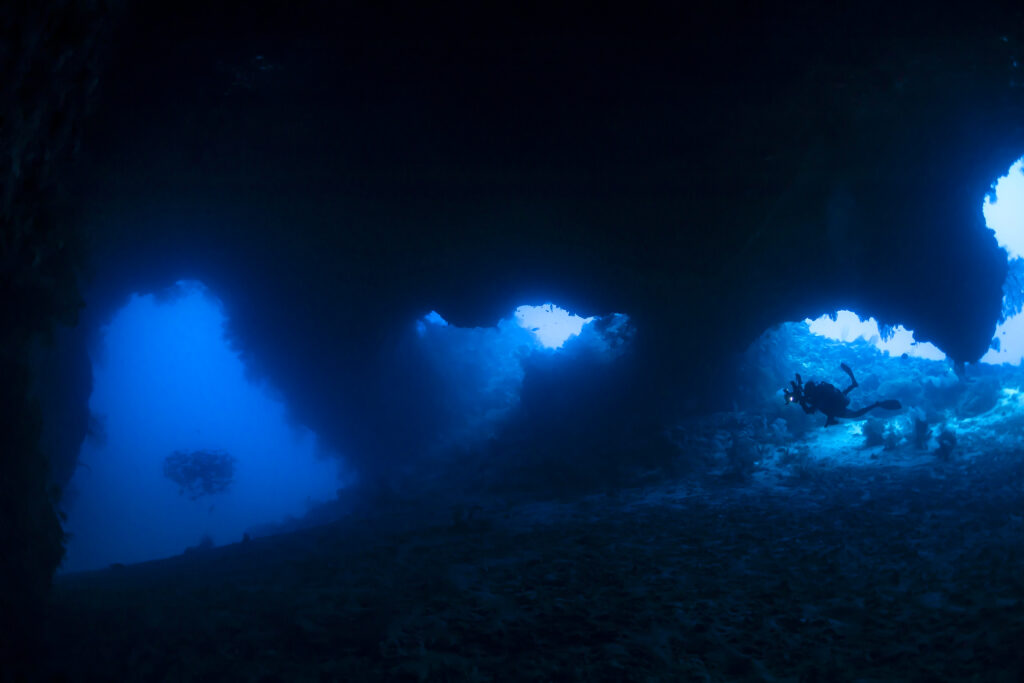
While the terms cavern and cave diving are sometimes used interchangeably, they refer to two different types of underwater experiences, each with its own set of rules, training requirements, and safety considerations.
Cavern Diving
Cavern diving is a type of recreational diving that takes place in the entrance areas of underwater caves. Some key elements of cavern diving include:
- Light Penetration: Divers typically remain inside an area where natural light is visible, with a clear view of the exit.
- Penetration Distance: In cavern diving, the maximum penetration is typically limited to 60 meters (approximately 200 feet) from the surface.
- Training Requirements: To do cavern diving, a specialized cavern diving certification is required. The certification can be obtained through recreational diving agencies.
- Equipment: Uses standard scuba gear with additional safety equipment like reels and lights.
- Risk Level: While less risky than cave diving, cavern diving still requires adherence to safety protocols due to the overhead environment.
Cave Diving
Cave diving is a type of technical diving that involves diving into deeper parts of underwater caves beyond the reach of natural light. Here are some characteristics of cave diving:
- Complete Darkness: Divers venture outside the zone of natural light and rely entirely on artificial lighting.
- Extended Penetration: There’s no fixed distance limit for cave diving, but penetration is constrained by gas volume (Rule of Thirds), diver experience, and cave complexity.
- Advanced Training: Divers must have specialized cave diving certifications, which involve rigorous training in navigation, buoyancy control, emergency procedures, and the use of guidelines.
- Specialized Equipment: Requires redundant systems, including multiple tanks, regulators, and lights, to manage the increased risks.
- Higher Risks: Due to the challenging terrain, lack of direct access to the surface, and potential for disorientation, cave diving carries a significantly higher risk and is only recommended for highly trained and experienced divers.
Why do Divers Explore Caves and Caverns?
Despite the risks and challenges, divers are drawn to caves and caverns for several reasons. Underwater caves and caverns offer unique and rare opportunities to explore landscapes that may be difficult to find anywhere else, from intricate passageways, rare geological formations, and ecosystems that have evolved in isolation.
The allure lies not only in the physical challenge but also in the chance to see parts of the planet that few have seen, making each dive feel like a rewarding adventure.
However, beyond the thrills, cave and cavern diving play an important role in scientific research and environmental conservation. Researchers utilize these forms of diving to study unique aquatic species, understand geological processes, and gather important data for preserving these fragile ecosystems.
What Training and Certification are Required?
Cave diving is an inherently high-risk activity that demands extensive, rigorous training, specialized equipment, and unwavering discipline. The number of incidents related to cave diving has emphasized how important it is to have proper preparation and adherence to safety protocols.
The Cave Diving Training Progression
In general, training for cave diving follows a structured progression, and each level builds upon the skills and knowledge acquired in the previous one. Among the many diving certification providers, Technical Diving International (TDI) is one of the most respected and widely recognized organizations for technical and cave diving training.
TDI’s Cave Diving Certification Pathway
- Cavern Diver: An introductory course focusing on diving within the light zone of a cave. You will learn about line handling, emergency procedures, gas management, and how to safely navigate through the cavern while maintaining a continuous guideline to the surface.
- Intro to Cave Diver: Taken after completing the Cavern Diver Course. This level introduces you to limited penetration into cave environments beyond the light zone. Training includes advanced gas planning, and handling potential emergencies in an overhead environment.
- Full Cave Diver: The highest level of TDI’s cave diving training. This course will prepare you for extensive cave penetrations, including traverses and complex navigation scenarios. Emphasis is placed on dive planning, problem-solving, and mastering advanced propulsion techniques.
Each level requires successful completion of the prerequisite course to ensure that every diver has a solid foundation of skills and knowledge. You will be trained to handle the unique challenges of cave environments, such as zero visibility, tight passages, and potential equipment failures.
Emphasizing Safety and Preparedness
Thorough training is extremely crucial for cave diving, as it involves significant risks, including but not limited to disorientation, equipment failure, and environmental hazards. It is imperative to undergo professional training and obtain proper certification before attempting any cave dives. Remember to always dive within the limits of your training and experience.
Best Cave Diving Destination
Curious about what it would feel like to go diving in caves? Here are five of the world’s most renowned cave diving locations:
1. Chandelier Cave, Palau
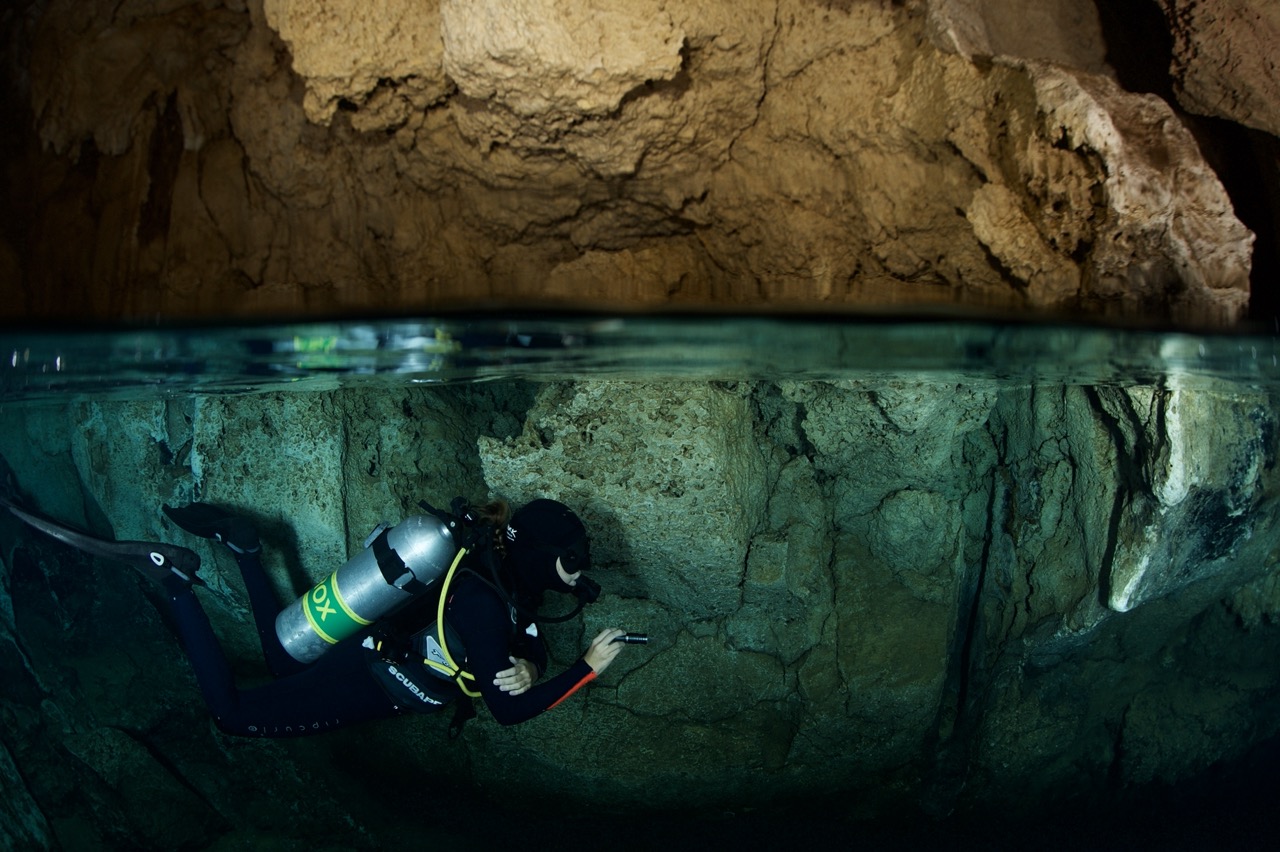
Located near Koror, Chandelier Cave is a series of five interconnected chambers with stunning stalactite and stalagmite formations. There are air pockets in the cave, where you can surface to get air, making it a unique experience. Chandelier Cave is also known to be an easy cave dive destination, even for beginners. However, proper buoyancy control is still required for a smooth and enjoyable journey.
2. Great Blue Hole, Belize
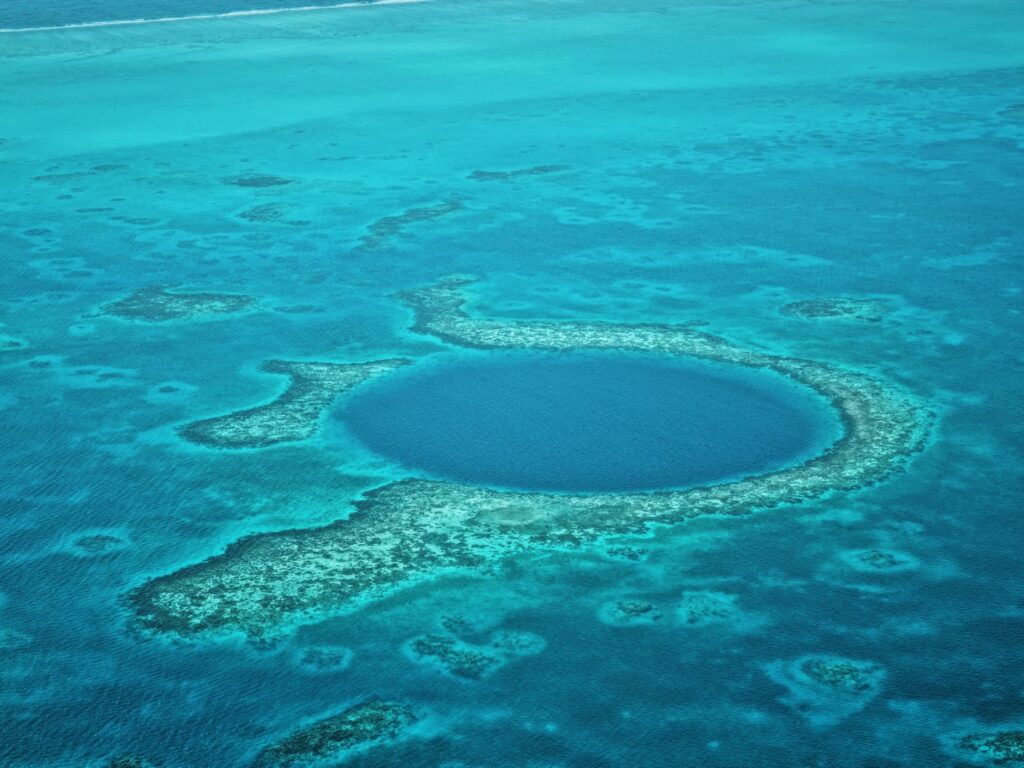
The Great Blue Hole is a massive marine sinkhole off the coast of Belize. It measures over 300 meters across and 124 meters deep, offering divers the chance to explore ancient limestone formations and encounter diverse marine life, from reef sharks to giant groupers. However, due to its depth and challenging conditions, diving in the Great Blue Hole is considered an advanced dive. Proper training, experience, and certification are essential to safely for Blue Hole cave diving.
3. Shark Cave, Philippines
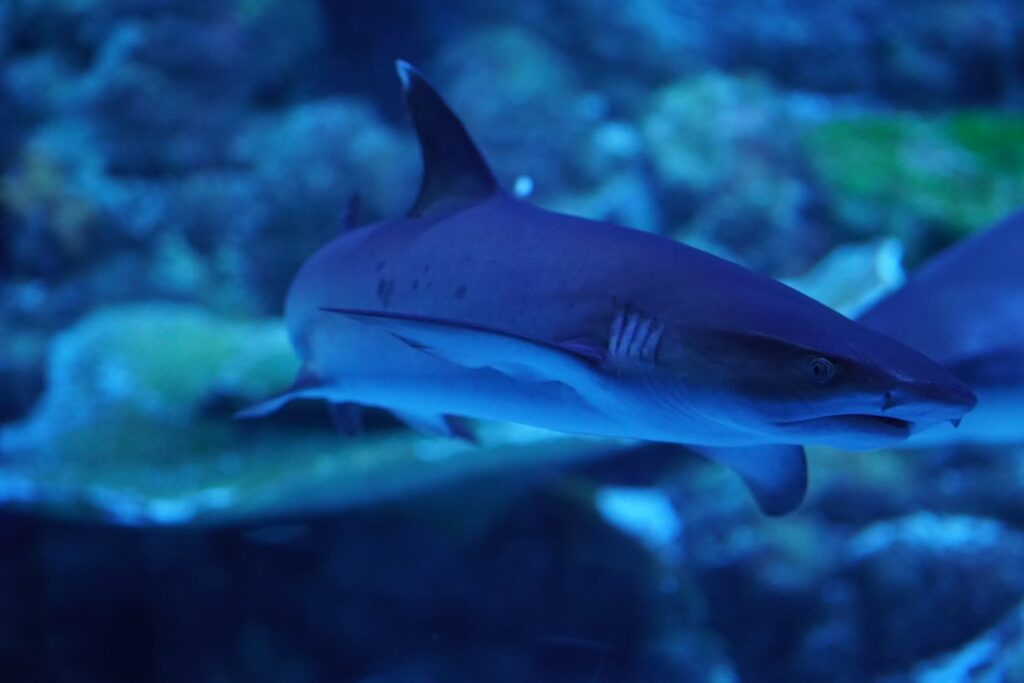
Located off Escarceo Point in Puerto Galera, the Shark Cave is a renowned underwater site featuring a large overhang at approximately 27 meters depth. This natural formation serves as a favored resting spot for white-tip reef sharks during the day. Divers often observe these sharks in a dormant state, gently swaying with the water’s movement. However, due to its depth and potential for strong currents, this site is recommended for experienced divers, preferably using Nitrox to maximize bottom time.
4. Sac Actun System, Mexico
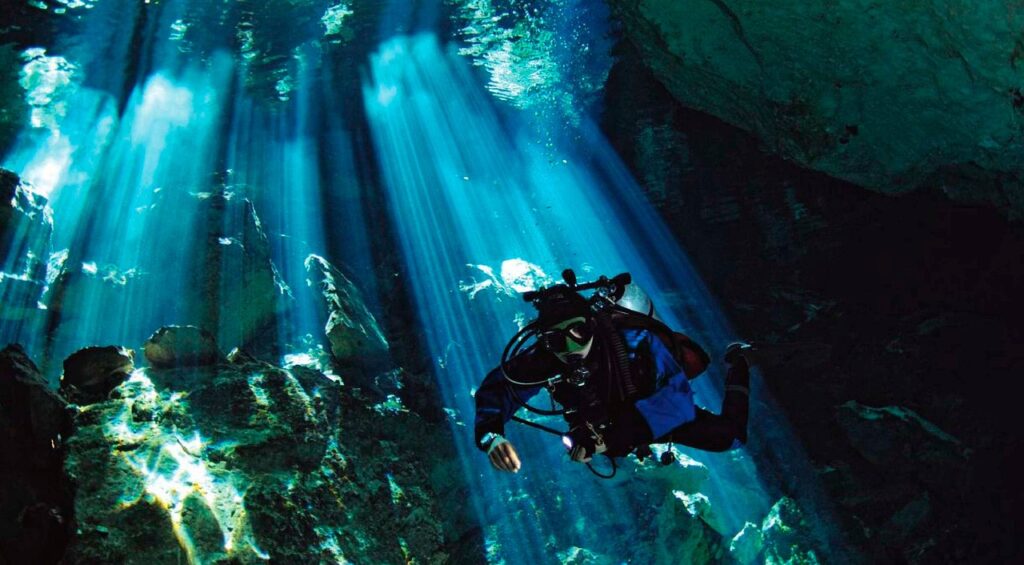
Sistema Sac Actun, or Sac Actun System, is one of the world’s most extensive underwater cave systems. With over 386 kilometers of mapped passages, Sac Actun has an intricate network of tunnels, chambers, and cenotes (natural sinkholes that provide access to the subterranean system). The system also holds significant archaeological importance, as it was the site where the remains of a teenage girl, dating back over 12,000 years, were discovered.
5. Nereo Cave, Italy
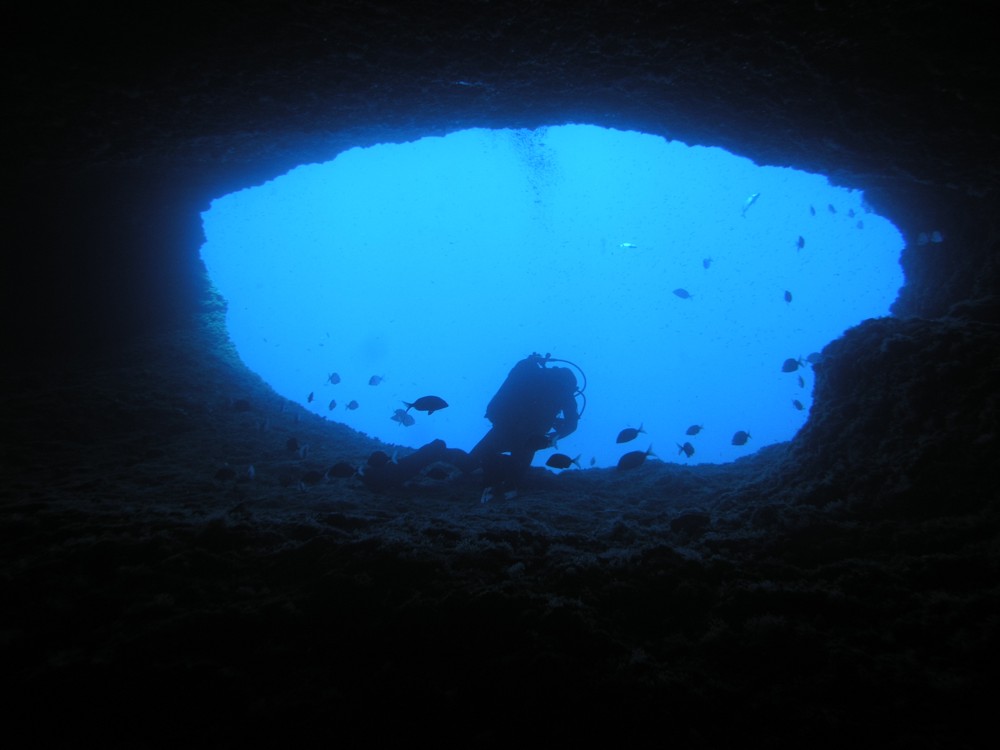
Nereo Cave, or Grotta di Nereo, is recognized as the largest underwater sea cave in the Mediterranean. With an extensive network of tunnels, arches, and chambers extending approximately 500 meters, with varied dive routes suitable for different skill levels. Marine life thrives here thanks its the nutrient-rich current, and you may encounter groupers, moray eels, lobsters, and vibrant corals adorning the walls.
What to Prepare Before Going on a Cave Dive?
Unlike any other form of diving, cave diving leaves no room for error. Proper planning, having the right equipment, and strong awareness of risks are crucial to ensure your safety and enjoyment. Here’s a list of things you need to know to have a safe cave diving adventure:
1. Important Cave Diving Equipment
Cave diving gear is more complex than standard scuba diving equipment. Redundancy is key, as you must be prepared for gear failure in a challenging environment. Be sure to at least pack these items with you:
- Primary and backup lights (at least three per diver).
- Guideline reels and spools for navigation and exit routes.
- Redundant air supply, such as dual tanks or sidemount configurations, to make sure you have alternative air sources.
- Wetsuit or drysuit to prevent hypothermia.
- At least one, preferably two, cutting devices to avoid entanglements.
- A dive computer and depth gauge to monitor depth and time.
- Backup mask.
- Emergency equipment, such as a first aid kit and an oxygen kit.
2. Safety Considerations
To avoid cave diving accidents, you’re going to need rigorous training and adherence to established protocol. Make sure that you are properly trained and only dive within the limits of your training. You should also plan your dive meticulously, covering depth, duration, gas management, and emergency procedures.
The rule of thirds is especially important in cave diving, so be sure to use one-third of your gas supply for the inward journey and one-third for the return. Keep one-third for reserve.
Lastly, always dive with a buddy and maintain close proximity and clear communication throughout the dive to avoid unwanted issues. Maintaining buoyancy is also extremely important, so you won’t disturb silt or damage cave formations, which may reduce visibility.
3. Understand the Major Risks of Cave Diving
There are several unique dangers of cave diving that aren’t found in open water diving, such as:
- Disorientation and getting lost
- Air supply depletion
- Equipment failure
- Hypothermia
- Entrapment
Always make sure to never lose sight of your guidelines, stay close to your buddy, and prepare a careful, thorough dive plan before you start your diving journey to avoid encountering these issues.
4. Causes of Cave Diving Accidents and How to Prevent Them
Cave diving incidents often happen due to a combination of factors, namely inadequate training, poor planning, equipment neglect, and complacency. To prevent these accidents, you are highly recommended to regularly update your cave diving training and skills, have strict adherence to protocols, regularly maintain and inspect your gear before each dive, practice emergency drills, and have contingency plans.
By thoroughly preparing and respecting the cave environment, you can mitigate risks and have a safe cave diving journey.
Is Cave and Cavern Diving Right for You?
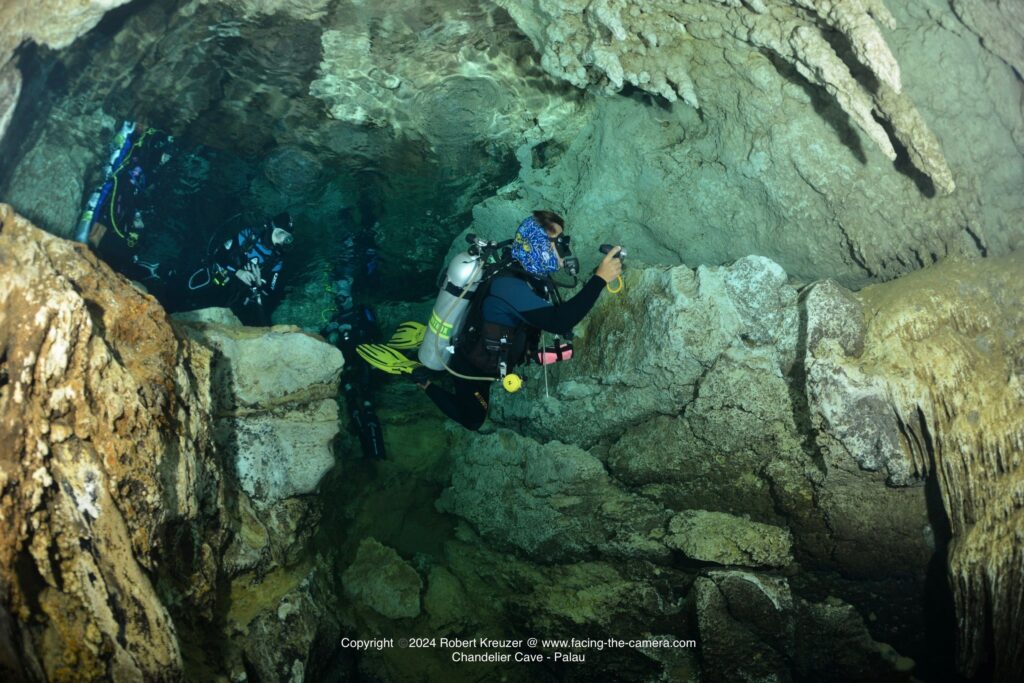
If you crave adventure and have the right skills, certifications, and mindset, cave and cavern diving can be an incredibly rewarding experience. But it’s essential to train rigorously, plan carefully, and understand the risks involved.
For those curious but unsure, Chandelier Cave in Palau offers a gentle introduction to overhead environments. It’s a relaxed yet fascinating dive, which you can enjoy with us at Solitude World’s Liveaboards and Resorts!
Our liveaboard vessel, Solitude Gaia, will take you to Chandelier Cave and other renowned dive sites in Palau, with PADI-certified guides onboard to ensure a safe and enjoyable experience. Whether you’re new to cave diving or expanding your skills, always dive with respect for the environment and full awareness of the challenges.
With expert guidance, thorough preparation, and a safety-first approach, cave and cavern diving can be both unforgettable and fulfilling. When you’re ready, Solitude World is here to guide you on a mesmerizing journey beneath the surface.
Book your next diving adventure with us here today!